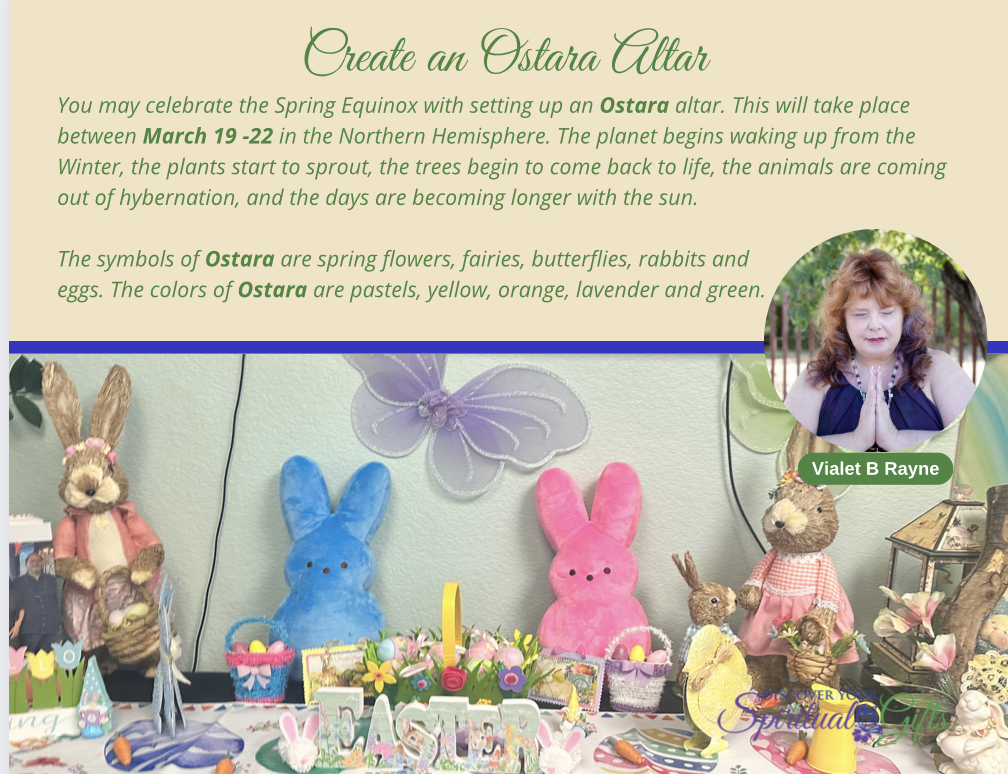Happy Ostara season! It may not feel like it here in Colorado, but spring is here.
Many ancient cultures followed the cycles of nature and the changing of the seasons to mark time and to understand the world around them. The four seasons represent different aspects of daily life and were often, but not always, associated with different gods or goddesses.
In many traditional societies, seasonal changes were linked to agricultural cycles, and the planting and harvesting of crops were timed according to the rhythms of nature. In some cultures, the changing of the seasons was marked with ceremonies and rituals that expressed their gratitude for an abundant harvest and honored the gods and goddesses of the earth and sky.
In many indigenous cultures around the world, the changing of the seasons was also marked with ceremonies and rituals that honored the natural world and its cycles. These traditions often emphasized the interconnectedness of all life and the importance of living in harmony with nature.
What is Ostara?
Ostara is a pagan holiday that celebrates the spring equinox, which occurs around March 20th or 21st in the Northern Hemisphere. It is one of the eight major festivals in the Wheel of the Year, which is a cycle of seasonal celebrations observed by many pagan traditions.
What is the Wheel of the Year?
The Wheel of the Year is a modern pagan concept that represents the cyclical nature of time. It is a symbolic representation of the eight major festivals that mark the changing of the seasons throughout the year.
The Wheel of the Year is divided into two halves, each representing the light and dark halves of the year. The first half begins with the winter solstice, which marks the longest night of the year, and continues through the spring equinox and the summer solstice. The second half is the late summer and harvest seasons from the summer solstice, back to the beginning with the winter solstice.
I like to think of the Wheel of the Year festivals as the perfect complement to the celebration of the moon phases. The moon cycles are more feminine in nature, whereas these are sun festivals – the perfect masculine balance to our monthly moon rituals and ceremonies.
As sun festivals, all eight celebrations incorporate enjoying the perks of fire – whether it’s a bonfire or a candle, enjoying a feast with loved ones, and getting outside in nature.
Tell Me More About Ostara
As the wheel turns, Ostara is the name of the celebration that occurs over the spring equinox.
Ostara is named after the Germanic goddess Eostre, who was associated with spring, fertility, and new beginnings. The holiday is a time to welcome the return of spring and the renewal of life after the darkness and cold of winter. It is often marked with rituals and ceremonies that honor the changing of the seasons and the cycles of nature. Some common practices associated with Ostara include planting seeds, decorating eggs, and creating altars with spring flowers and symbols of fertility.
Celebrating Ostara
Here are some ways to honor and celebrate Ostara:
- Decorate your home: decorate your home with symbols of spring such as fresh flowers, pastel-colored ribbons, and Easter eggs.
- Plant a garden: plant seeds or start a garden to celebrate the return of spring and new growth.
- Cleanse your space: cleanse your home and yourself of any negative energy to make room for positive change.
- Have a feast: gather with friends and family and have a feast with traditional spring foods such as eggs, lamb, and fresh greens.
- Create an altar: create an altar with symbols of spring and new beginnings such as flowers, seeds, and eggs.
- Spring cleaning: if you are feeling the urge to do a bit of spring cleaning, make it sacred by diffusing lemon oils, playing springtime music, and clearing and setting sacred space for the season.
- Meditate: take time to reflect on the past and set intentions for the future.
- Perform a ritual: perform a ritual to welcome spring and the renewal of life.
- Connect with nature: spend time outside in nature, take a walk, and appreciate the beauty of the season.
- Practice gratitude: give thanks for the abundance of nature and the blessings in your life.
Remember, there is no one “right” way to celebrate Ostara. Follow your intuition and do what feels right for you.
Overall, Ostara is a celebration of hope, growth, and the cycles of nature, and it is observed by many as a time of spiritual and personal renewal.
What seeds will you plant this Ostara season to harvest later in the year? This is the perfect time to start something new, set an intention for yourself, appreciate the blessings of spring, or celebrate with friends and loved ones.
*****
WRITTEN BY NIKKI MILTON
NIKKI IS THE CENTER GUARDIAN & MARKETING MAGICIAN OF DISCOVER YOUR SPIRITUAL GIFTS. SHE WORKS AT THE CENTER ON MONDAYS, WEDNESDAYS, AND FRIDAYS. COME BY AND ALLOW US TO PROVIDE YOU WITH A TOUR OF THE CENTER.




